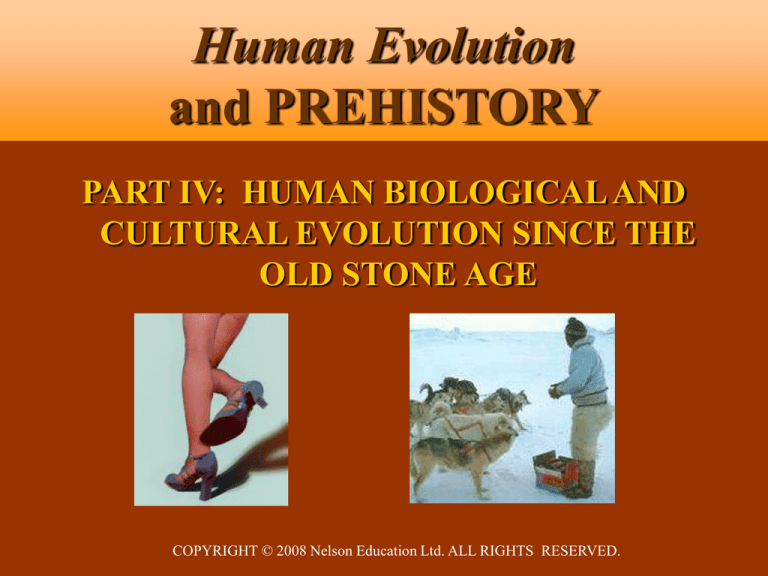
Human Evolution
and PREHISTORY
PART IV: HUMAN BIOLOGICAL AND
CULTURAL EVOLUTION SINCE THE
OLD STONE AGE
COPYRIGHT © 2008 Nelson Education Ltd. ALL RIGHTS RESERVED.
Human Evolution
and PREHISTORY
Chapter Eleven:
CULTIVATION AND
DOMESTICATION
Link to the Canadian Archaeological Association
COPYRIGHT © 2008 Nelson Education Ltd. ALL RIGHTS RESERVED.
Chapter Preview
When And Where Did The Change From Food
Foraging To Food Production Begin?
Why Did The Change Take Place?
What Were The Consequences Of The Change To
Food Production?
COPYRIGHT © 2008 Nelson Education Ltd. ALL RIGHTS RESERVED.
PALEOLITHIC SUBSISTENCE
STRATEGIES
Dependence on wild sources of food
No evidence to indicate that livestock was kept
or plants cultivated
About 12,000 ya the Neolithic period began,
when people became farmers rather than food
foragers
COPYRIGHT © 2008 Nelson Education Ltd. ALL RIGHTS RESERVED.
THE POSTGLACIAL ROOTS OF
FARMING AND PASTORALISM
By 12,000 years ago the glaciers were receding and
sea levels were rising
Climatic change caused the herd mammals of the
Paleolithic either to move or die out
People were collecting a broad spectrum of food
resources – forest animals, birds, fish, plants
This way of life was first seen in Israel, 23,000 ya
COPYRIGHT © 2008 Nelson Education Ltd. ALL RIGHTS RESERVED.
THE POSTGLACIAL ROOTS OF
FARMING AND PASTORALISM
No single tradition emerges from the Paleolithic
Mesolithic in Europe and adjacent regions
Epipaleolithic in West and East Africa
In the New World, the post-Paleoindian groups are
known as Archaic cultures
COPYRIGHT © 2008 Nelson Education Ltd. ALL RIGHTS RESERVED.
Early Postglacial Tools and Weapons
Ground stone tools made into
axes, adzes and gouges, e.g. to
make boats, clear forests
Microliths (small but hard,
sharp blades) to be used for
sickles, harpoons, arrows,
daggers – composite tools
Permanent dwellings, as
people became sedentary
COPYRIGHT © 2008 Nelson Education Ltd. ALL RIGHTS RESERVED.
Early Postglacial Pottery
Oldest undisputed pottery dates to about 17,000 to 15,000 years
ago in Japan, Russian Far East and China
In the Americas and other parts of the world, pottery was an
important part of non-agricultural people’s technology
Pottery vessels were important for food storage and preparation
Decoration was often symbolic and even defined social roles
Manufacture requires great skill and sophistication
COPYRIGHT © 2008 Nelson Education Ltd. ALL RIGHTS RESERVED.
CULTURAL DIVERSITY IN THE
POSTGLACIAL PERIOD - The Natufians
12,500 to 10,200 years ago at the eastern
end of the Mediterranean Sea
Caves, rock shelters, small villages with
stone and mud houses
Communal cemeteries
Food storage pits
Sickles made from microliths set in wood
or bone
COPYRIGHT © 2008 Nelson Education Ltd. ALL RIGHTS RESERVED.
The New World
Microlith technology from northeast Asia spread
from the western Arctic into British Columbia,
Alberta, eastern Arctic
Archaic cultures were widespread
Maritime Archaic, 7,000 ya, Gulf of St. Lawrence
Bone and ground slate tools for hunting sea
mammals in dugout canoes
Burial ceremonialism with red ochre
COPYRIGHT © 2008 Nelson Education Ltd. ALL RIGHTS RESERVED.
The New World
In eastern North America, Archaic cultures
adapted to riverine woodlands
Sedentary because of reliance on fish, shellfish,
small mammals, deer
Shellmounds (garbage heaps) developed
Trade
Beginning of plant domestication, e.g.
sunflowers
COPYRIGHT © 2008 Nelson Education Ltd. ALL RIGHTS RESERVED.
Low-level Producers
Many societies added domesticated plants or animals to their
hunting and gathering regime and were known as low-level
producers, e.g. the Natufians, Jomon of Japan
In other cases, natural resources were so abundant that
management techniques were required, e.g. First Nations
communities in British Columbia who used burning and
limited transplanting
Others harvested wild plants by modifying their
environment (anthropogenesis), e.g. burning, flooding
COPYRIGHT © 2008 Nelson Education Ltd. ALL RIGHTS RESERVED.
Low-level Producers – Jomon of Japan
13,000 – 3,000 ya (1,500 in north)
Many call them affluent foragers, with a way
of life similar to First Nations in coastal B.C.
Developed many characteristics of
agricultural societies, but with few
domesticated resources
Balanced and intensive agriculture is not
always inevitable
COPYRIGHT © 2008 Nelson Education Ltd. ALL RIGHTS RESERVED.
THE NEOLITHIC REVOLUTION
Transition from foraging for food to
dependence upon domesticated plants
and animals
One of the first regions to undergo this
transition was Southwest Asia, before
8,000 years ago
COPYRIGHT © 2008 Nelson Education Ltd. ALL RIGHTS RESERVED.
Domestication
Domestication is an evolutionary process
whereby humans modify, either intentionally or
unintentionally, the genetic makeup of a
population of plants or animals, sometimes to
the extent that members of the population are
unable to survive and/or reproduce without
human assistance
COPYRIGHT © 2008 Nelson Education Ltd. ALL RIGHTS RESERVED.
Evidence of Early Plant
Domestication
Traits of domesticated plants:
1.
2.
3.
4.
5.
Increased size
Reduction or loss of natural
means of seed dispersal
Reduction or loss of protective
devices, e.g. husks
Loss of delayed seed
germination
Development of simultaneous
ripening of the seed or fruit
COPYRIGHT © 2008 Nelson Education Ltd. ALL RIGHTS RESERVED.
Plant Domestication
Structural changes in plants, such as soft to tough
stems, involve genetic change that is the result of
unconscious selection
The preservation of valued individuals and the
destruction of less valued ones, with no thought as
to long-range consequences
Compare our large ear of corn (maize) today,
compared with early maize, about one inch long
COPYRIGHT © 2008 Nelson Education Ltd. ALL RIGHTS RESERVED.
Evidence of Early Animal
Domestication
1. Change in skeletal structure, e.g. horn shape
2. Size of the animal or its parts, e.g. teeth
3. Age/sex ratios of butchered animals at a site
will indicate whether females are being kept
for breeding, a first step in the domestication
process
COPYRIGHT © 2008 Nelson Education Ltd. ALL RIGHTS RESERVED.
Beginnings of Domestication
1. Food foragers are a wealth of knowledge about the
resources of the natural environment, and remain
foragers by choice, not ignorance; they apply their
knowledge to actively manage the resources on
which they depend
2. Food production does not free people from hard
work, and requires the eating of more “thirdchoice” foods
3. Food production is not a more secure means of
subsistence
COPYRIGHT © 2008 Nelson Education Ltd. ALL RIGHTS RESERVED.
WHY HUMANS BECAME FOOD
PRODUCERS
1. Dessication, or “oasis”, theory (V. Gordon Childe)
2. “Hilly flanks” theory (R. Braidwood)
3. Pressure of population growth
The most likely theory…..
The process of becoming food producers was a
consequence of a chance convergence of
independent natural events and cultural
developments, e.g. Natufians
COPYRIGHT © 2008 Nelson Education Ltd. ALL RIGHTS RESERVED.
The Natufians – Plant domestication
Between 12,000 and 6,000 ya, extreme
seasonality developed, with long dry
periods
The best adapted plants were annuals like
wild cereal grains and legumes
The Natufians adapted by firing land to
promote grazing and by collecting seeds
from the wild annuals
Seed storage plus water scarcity promoted
sedentary living
They already possessed tools for
harvesting reeds and processing wild foods
COPYRIGHT © 2008 Nelson Education Ltd. ALL RIGHTS RESERVED.
The Natufians – Domestication
While harvesting, easily dispersed seeds would be
“lost” at the site
Seeds for non-dispersing variants were carried back
to settlements
Some would germinate and grow on dump heaps,
cleared areas, etc.
COPYRIGHT © 2008 Nelson Education Ltd. ALL RIGHTS RESERVED.
The Natufians -- Domestication
Many of the plants that became domesticated were
colonizers, which do well in disturbed habitats
These habitats increased with sedentism and
therefore these colonizing plants spread
The animals that became domesticated were those
already being hunted (e.g. wild sheep), and they
were “managed” by being gradually introduced
outside their natural habitat
COPYRIGHT © 2008 Nelson Education Ltd. ALL RIGHTS RESERVED.
Animal domestication in
Southwest Asia
Began in the hilly country of
Turkey, Iraq and Iran
Large herds of wild sheep and
goats as well as great
environmental diversity
Today, transhumance is
practised, moving the herds
from the winter low steppe to
the summer high pastures
COPYRIGHT © 2008 Nelson Education Ltd. ALL RIGHTS RESERVED.
Other Centres Of Domestication
East Asia
rice and soybean became major food crops
Water buffalo and East Asian pig
Domesticated rice appears by 8,500 to 8,000 years ago
New World
Maize (Mexico) and potatoes (Peru), two of the most
important food crops in the world, as well as tomatoes
Earliest occurrence of maize is 7,700 years ago in Mexico
Guinea pigs, llamas, dogs, turkeys
COPYRIGHT © 2008 Nelson Education Ltd. ALL RIGHTS RESERVED.
Domestication
Domestication occurred independently in several parts of the
world
However, people domesticated the same categories of food –
starch grains (or root crops) accompanied by one or more
legumes
COPYRIGHT © 2008 Nelson Education Ltd. ALL RIGHTS RESERVED.
THE SPREAD OF FOOD
PRODUCTION
From the primary origins in at
least eight centres throughout
the world, many secondary
shifts to agriculture occurred,
stimulated by population
growth
Farmers migrated, the idea of
agriculture spread, crops and
animals were introduced
outside the centre of origin
COPYRIGHT © 2008 Nelson Education Ltd. ALL RIGHTS RESERVED.
THE SPREAD OF FOOD
PRODUCTION
As people moved with their crops into new areas,
new alleles were introduced into human gene pools
Languages spread, e.g. modern distribution of
Bantu-speakers in sub-Saharan Africa
In some areas a combination of adoption of farming
by hunters-gatherers and migration occurred, e.g.
Grand River valley in Ontario
COPYRIGHT © 2008 Nelson Education Ltd. ALL RIGHTS RESERVED.
Effects on Society
1.
Increased fertility across human populations
2.
Increased instability of resources as the focus
shifts to only those foods with the highest yields
3.
Greater dependence on a narrow range of
resources
4.
Increased likelihood of spread of disease
throughout the crops
COPYRIGHT © 2008 Nelson Education Ltd. ALL RIGHTS RESERVED.
ORIGINAL STUDY
Pre-contact Agriculture in Ontario:
The Iroquoians
Prior to A.D. 1100 the Princess Point peoples lived on a large floodplain in
southern Ontario, the perfect setting for the first agriculture
Corn appears by A.D. 450, heralding the beginning of an agricultural society
Around A.D. 1100 the first Iroquoian longhouses appear, and by A.D. 1300,
sunflower, squash, and tobacco appear at sites, followed later by beans
The culture of the Iroquoians became firmly rooted in agriculture
COPYRIGHT © 2008 Nelson Education Ltd. ALL RIGHTS RESERVED.
Culture of Neolithic Settlements
Old World
Small village farming
communities
New tools, e.g. plows, pestles
and mortars
Courtesy of Mesa Community College, Anthropology
Long-distance trade
Significant expansion in
manufacture and use of pottery
COPYRIGHT © 2008 Nelson Education Ltd. ALL RIGHTS RESERVED.
Abu Hureyra, Syria
11,500 to 7,400 years ago
Euphrates River valley
In the beginning, the people were food foragers – gazelle, nuts,
wild grains, river valley plants
Within 500 years the first crop, rye, was being grown and
people stopped collecting
The turn to farming coincided with the onset of a cool, dry
period
When warm weather returned, the settlement reorganized into
a large, permanent agricultural community
COPYRIGHT © 2008 Nelson Education Ltd. ALL RIGHTS RESERVED.
Technology Necessary for Agriculture
1. Tools for
plowing,
harvesting,
processing
2. Pottery –
significant expansion
in manufacture and
use
COPYRIGHT © 2008 Nelson Education Ltd. ALL RIGHTS RESERVED.
Culture of Neolithic Settlements
Complex housing design for
homes, made with a variety
of materials
Clothing made of woven
textiles
Relatively egalitarian
society with minimal
division of labour
COPYRIGHT © 2008 Nelson Education Ltd. ALL RIGHTS RESERVED.
Neolithic Culture in the New
World
Agricultural villages do not appear until
4,500 years ago in Mesoamerica and
Peru
Hunting, fishing and gathering remained
very important outside of Mesoamerica
and Peru
COPYRIGHT © 2008 Nelson Education Ltd. ALL RIGHTS RESERVED.
ORIGINAL STUDY
History of Mortality and Physiological Stress
With high degrees of sedentism, population density, and
reliance on intensive agriculture, physiological stress and
mortality rates greatly increased
There were high frequencies of nutritional problems (e.g.
chronic iron-deficiency anemia), increase in tooth disease,
decrease in stature
This stress was related to factors such as the poverty of
nutrients in staple crops, periodic famines, and chronic lack of
food
COPYRIGHT © 2008 Nelson Education Ltd. ALL RIGHTS RESERVED.
THE NEOLITHIC AND HUMAN
BIOLOGY
Studies of human skeletons show people with less
wear on their teeth, less robust bones, and less
osteoarthritis than Paleolithic and Epipaleolithic
peoples
Poor sanitation was a key factor in the increased
incidence of disease and mortality
New farming practices increased the opportunities
for endemic malaria
COPYRIGHT © 2008 Nelson Education Ltd. ALL RIGHTS RESERVED.
THE NEOLITHIC AND THE IDEA OF
PROGRESS
Rather than seeing food production as a
great step upward in the steady progress
of human history, it should be viewed as
one of many adaptive strategies invented
by humans over time
Other strategies have been huntinggathering, horticulture, pastoralism, and
intensive agriculture.
COPYRIGHT © 2008 Nelson Education Ltd. ALL RIGHTS RESERVED.
NEXT TIME:
The Rise of Cities and
Civilizations
COPYRIGHT © 2007 Nelson, a division of Thomson Canada Limited. ALL RIGHTS RESERVED.










